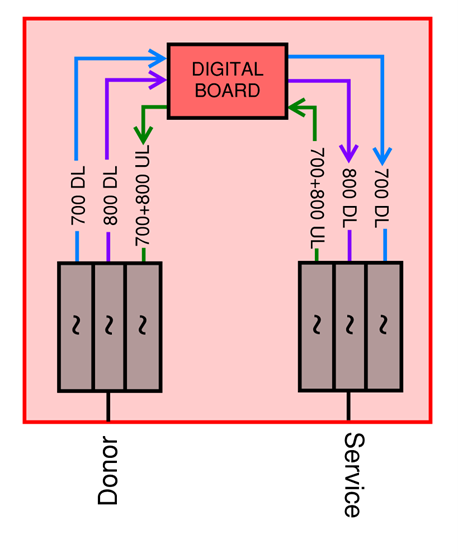With the nationwide deployment of AT&T FirstNet LTE in band 14, it is becoming more and more common to have high, interfering signal from AT&T towers into public safety signal boosters. This is based on BDAs being built to cover more than just the narrowband public safety – they tend to cover 700MHz LTE Band 14 (FirstNet), 700MHz Narrowband, 800MHz public safety, and 800MHz ESMR.

Let us take a look at three of the most common (digital) BDAs in the market. We see the passbands as follows:
OEM 1:

OEM 2:

OEM 3:

These three digital BDAs are built similarly – you have a donor antenna input to a triplexer (which passes the bands as shown above), then a low noise amplifier, followed by a digital board, followed by power amplifiers, followed by a second triplexer, then to your service antennas:

FirstNet is typically not amplified by the BDAs, so the digital filter that would pass it is turned off. The problem arises when the FirstNet signal is significantly stronger than the desired 700MHz narrowband signal. There have been many deployments recently with an AT&T FirstNet site on a roof or tower, and a public safety donor antenna just across the street pointing in the general direction of the FirstNet site. At a distance of 100’, with a 20 Watt base station transmitter for FirstNet, the BDA might be pickup up a -17dBm signal from FirstNet, while only picking up -50 to -60 dBm from the desired narrowband public safety channels. This 30-40 dB delta is compensated for by the BDA, but it can do one of two things:
- Decrease the total output power of the 700MHz downlink from the BDA, which could lead to in-building coverage issues
- Decrease the SNR of the incoming 700MHz downlink signal (because the BDA has to attenuate as compensation for the FirstNet), leading to in-building signal quality issues.
Depending on which BDA is used, this is usually a combination of the two scenarios above (each BDA OEM has their own formula to account for this).
As the system integrator, it is your responsibility to ensure that you have the correct filter. We have found two so far that work great:
Comba FP-78-IN2: https://www.combausa.com/en/products/public-safety-communications/700-800mhz-public-safety-filters
Westell CS09-768-845: https://www.westell.com/products/cs09-768-845
The Comba version is our preferred one (better rejection, better roll off), however, we haven’t had issues with either.
In our experience, we are putting these filters onto the BDA to ensure AT&T FirstNet does not interfere with our system. What this does is also ensure our BDA does not interfere with FirstNet. If you look at the datasheets for the two products above, you’ll notice they also filter out the FirstNet UL signal. This ensures that our UL power amplifier does not cause a noise rise on the AT&T tower either, meaning when we commission a BDA, we can be positive that our building owner will never get a call from AT&T telling them to turn off the public safety BDA!
Please reach out to us with any questions regarding solving the FirstNet issue with BDAs!
** And to those of you wondering, this is a difficult problem for the OEM to solve. Jurisdictions put “FirstNet” into their BDA requirements, but at least as of this writing, AT&T does not want FirstNet to be amplified through a BDA, leading to the OEMs to recommend filtering before to ensure no interference.
